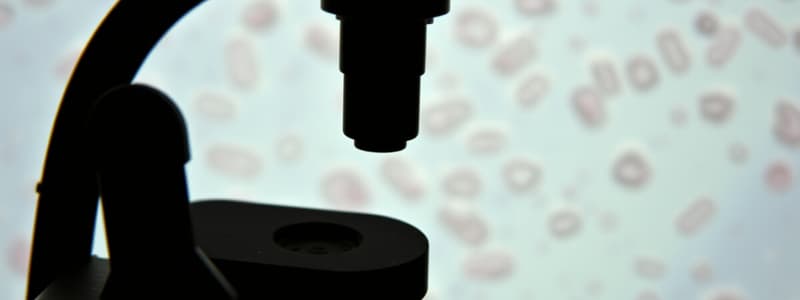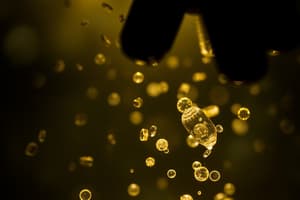Podcast
Questions and Answers
What is the main reason for using oil with the 100X objective?
What is the main reason for using oil with the 100X objective?
- Oil minimizes light refraction between air and glass. (correct)
- Oil allows for higher magnification levels.
- Oil improves the stability of the microscope.
- Oil enhances the color contrast of the specimen.
Which factor does not influence the resolution of a microscope?
Which factor does not influence the resolution of a microscope?
- Numerical aperture of the lens.
- Magnification level of the lens. (correct)
- Wavelength of light used for illumination.
- Type of microscope being used.
What is the highest resolution achievable with a bright light microscope?
What is the highest resolution achievable with a bright light microscope?
- 0.5 μm
- 0.1 μm
- 0.2 μm (correct)
- 1 μm
What is the primary advantage of dark-field microscopy?
What is the primary advantage of dark-field microscopy?
Which statement is true regarding the use of bright light microscopes?
Which statement is true regarding the use of bright light microscopes?
What is the primary definition of a microorganism?
What is the primary definition of a microorganism?
What happens to the light that passes through the specimen when using the 100X objective without oil?
What happens to the light that passes through the specimen when using the 100X objective without oil?
How does a dark-field microscope achieve its imaging technique?
How does a dark-field microscope achieve its imaging technique?
Which of the following statements accurately describes Eukarya?
Which of the following statements accurately describes Eukarya?
What is the approximate cost of bright light microscopes typically found in labs?
What is the approximate cost of bright light microscopes typically found in labs?
What do Archaea and Bacteria have in common?
What do Archaea and Bacteria have in common?
Which type of microscopy is most appropriate for viewing the fine details of cellular structures?
Which type of microscopy is most appropriate for viewing the fine details of cellular structures?
What is the correct use of the 100X objective in microscopy?
What is the correct use of the 100X objective in microscopy?
Which statement differentiates magnification and resolving power in microscopy?
Which statement differentiates magnification and resolving power in microscopy?
Which of the following is a function of the parts of a bright light microscope?
Which of the following is a function of the parts of a bright light microscope?
Where are Archaea typically found, and what is a misconception many people have about them?
Where are Archaea typically found, and what is a misconception many people have about them?
What is the purpose of the coarse focus knob on a microscope?
What is the purpose of the coarse focus knob on a microscope?
What does the term 'parfocal' mean in relation to microscopes?
What does the term 'parfocal' mean in relation to microscopes?
What type of microscopy is necessary for examining intracellular structures without killing living organisms?
What type of microscopy is necessary for examining intracellular structures without killing living organisms?
How is total magnification calculated in a microscope?
How is total magnification calculated in a microscope?
What are the mechanical stage adjustment knobs used for?
What are the mechanical stage adjustment knobs used for?
Which microscopy technique utilizes a beam of electrons instead of light waves?
Which microscopy technique utilizes a beam of electrons instead of light waves?
What is the function of the fine focus knob on a microscope?
What is the function of the fine focus knob on a microscope?
What is the primary advantage of using fluorescence microscopy in medical diagnostics?
What is the primary advantage of using fluorescence microscopy in medical diagnostics?
Which magnification objective lens would likely provide the highest total magnification when used with a 10X ocular lens?
Which magnification objective lens would likely provide the highest total magnification when used with a 10X ocular lens?
What does a transmission electron microscope (TEM) allow researchers to visualize?
What does a transmission electron microscope (TEM) allow researchers to visualize?
What does the diaphragm in a microscope control?
What does the diaphragm in a microscope control?
Which property of phase-contrast microscopy enhances the visibility of various cellular organelles?
Which property of phase-contrast microscopy enhances the visibility of various cellular organelles?
What should be the first step when attempting to visualize a specimen using the 4X objective?
What should be the first step when attempting to visualize a specimen using the 4X objective?
What characteristic of electron microscopy contributes to its high resolving power?
What characteristic of electron microscopy contributes to its high resolving power?
Which microscopy technique allows for the detection of motility in organisms?
Which microscopy technique allows for the detection of motility in organisms?
What is the primary function of fluorescent dyes in fluorescence microscopy?
What is the primary function of fluorescent dyes in fluorescence microscopy?
What should be done first when using the microscope with a new slide?
What should be done first when using the microscope with a new slide?
What is the purpose of using the coarse adjustment knob initially?
What is the purpose of using the coarse adjustment knob initially?
What is the correct procedure before switching from the 100X objective back to a lower power objective?
What is the correct procedure before switching from the 100X objective back to a lower power objective?
What type of bacterial morphology should students be able to identify on the slides?
What type of bacterial morphology should students be able to identify on the slides?
Which adjustment is made to optimize the illumination of the specimen?
Which adjustment is made to optimize the illumination of the specimen?
What should students do with used slides after the procedure?
What should students do with used slides after the procedure?
Why is it important to familiarize oneself with the microscope at this stage?
Why is it important to familiarize oneself with the microscope at this stage?
How should the slides be positioned on the microscope stage?
How should the slides be positioned on the microscope stage?
Flashcards are hidden until you start studying
Study Notes
Microscopy Overview
- Microorganisms are living organisms too small to be observed with the naked eye.
- Three domains of life: Eukarya (with a nucleus), Archaea, and Bacteria (both without a nucleus).
- Domain Eukarya includes unicellular organisms like fungi, protozoa, and algae, as well as multicellular types.
Importance of Microscopy
- Microscopes are essential for examining microorganisms, stained specimens, and diagnosing diseases.
- Bright light microscopes are commonly used in microbiology labs due to their affordability (~$1300) and user-friendliness.
Parts of a Bright Light Microscope
- Objective lenses (4X, 10X, 40X, 100X) for varying magnification.
- Ocular lens (10X) works with objectives to calculate total magnification (objective magnification × ocular magnification).
- Key parts include arm, specimen holder, coarse and fine focus knobs, mechanical stage, condenser, diaphragm, and light source.
Using a Microscope
- Coarse adjustment knob for initial specimen visualization; fine adjustment knob for sharp focus.
- The 100X objective requires immersion oil to minimize light refraction.
- Parfocal design allows for easy transition between objective lenses without significant focus loss.
Magnification vs. Resolving Power
- Magnification increases specimen size, while resolving power distinguishes between two separate entities.
- Maximum resolution with bright light microscopy is approximately 0.2μm; closer objects cannot be resolved.
Types of Microscopy
- Dark-field microscopy: illuminates unstained and living specimens, useful for viewing spirochetes.
- Phase-contrast microscopy: enhances cellular organelles' refractive properties for live specimens.
- Fluorescence microscopy: uses fluorochrome dyes to visualize specimens under UV light, helpful in medical diagnostics (e.g., Mycobacterium tuberculosis).
- Electron microscopy: utilizes electron beams for high resolving power, with two types: transmission (TEM) for internal structures and scanning (SEM) for surface topography.
Proper Usage and Care of Microscopes
- Always handle with care; transport and store properly.
- Adjust condenser and diaphragm for optimal illumination before viewing.
- Use appropriate cleaning methods to avoid damage after contacting oil with high-power objectives.
- Dispose of slides properly after use to maintain laboratory safety.
Practical Application
- Students should practice focusing and identifying stained bacteria (rod, cocci, spirilla) using provided slides.
- Familiarity with microscope handling is crucial for future microbiological techniques and studies.
Studying That Suits You
Use AI to generate personalized quizzes and flashcards to suit your learning preferences.




